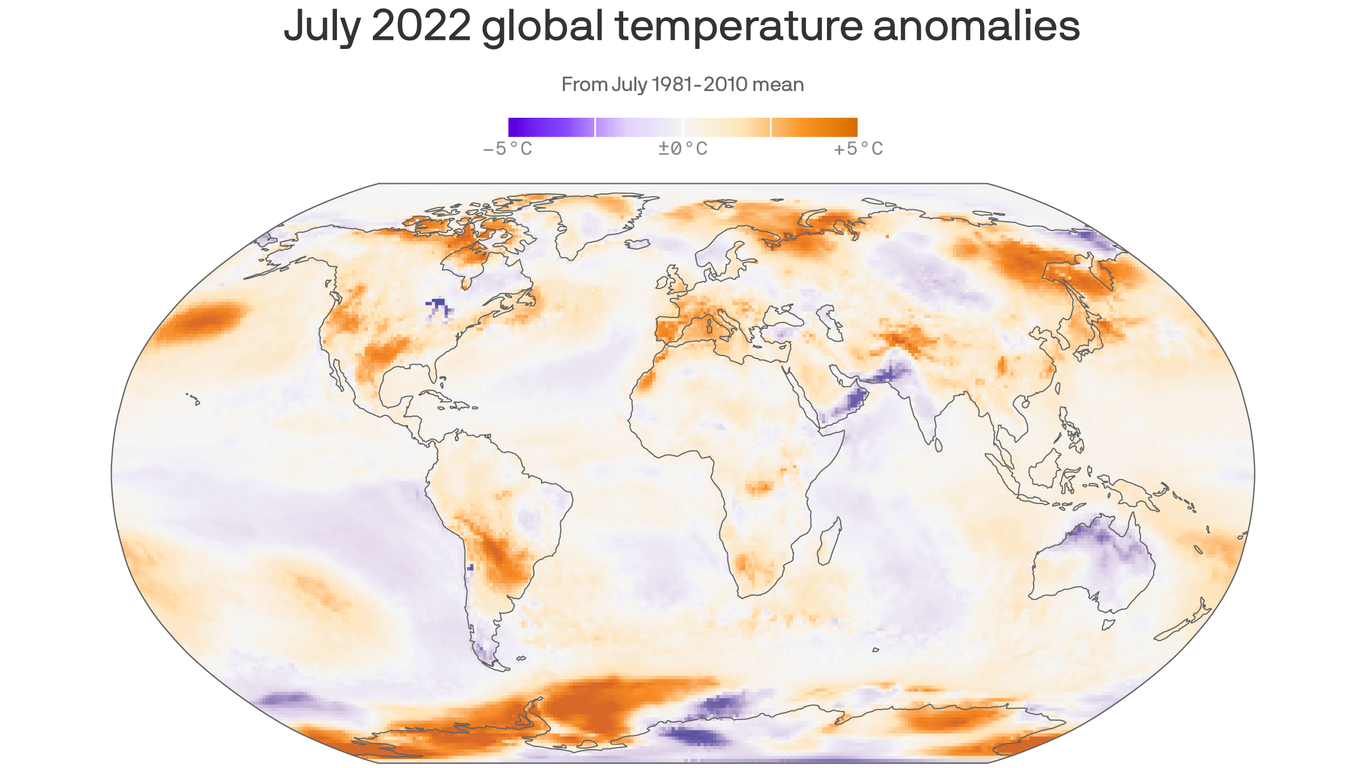
Unparalleled heat waves, drought, wildfires and deadly deluges made this July one of the three hottest on record worldwide, according to the Copernicus Climate Change Service.
Why it matters: The report is the first indication of where July stands in the annals of modern climate records, and it shows that the influence of human-caused global warming is having a profound impact on summer temperatures.
- The unusual heat comes despite the presence of a cooling La Niña in the tropical Pacific Ocean, which tends to damper global average surface temperatures.
- Recent data from other centers, including NASA, had confirmed the summer’s unusual warmth through June.
- Forthcoming data from NASA and the National Oceanic and Atmospheric Administration (NOAA) may rank the month slightly differently among the top 10 warmest list.
Zoom in: According to Copernicus, which is an EU scientific program, July was 0.4°C (0.72°F) above the 1991-2020 average, but slightly cooler than the current record-holder of July 2019.
- And it was “marginally” milder than the second-warmest July, which occurred in 2016, the agency said in its climate bulletin.
- July 2022 will long be known for its extraordinary heat and drought, along with spates of wildfires that have continued into August, in western Europe.
- Heat waves drove July’s average maximum temperatures for southwestern Europe to record levels, while average overnight low temperatures were among the top three on record for southwestern Europe, Copernicus found.
Of note: The extraordinary and deadly heat waves that captured global headlines in mid-July originated from a combination of a powerful heat dome over the region and air flowing north from northwestern Africa.
- In England, a staggering 46 temperature stations saw readings meet or beat the country’s previous all-time record high of 101.6°F (38.7°C) on July 18 and 19, which is highly unusual. The highest temperature during the event was 104.54°F (40.3°C), in Coningsby.
- The heat combined with the dry conditions helped spark wildfires from Portugal to the U.K., with wildfires still occurring daily.
The intrigue: A study conducted soon after the U.K. heat wave found that the heat wave was at least 10 times more likely to occur, and at least 3.6°F (2°C) hotter on average, due to today’s high amount of greenhouse gases in the air compared to the preindustrial era.
Meanwhile… in the U.S., July was the third-hottest such month on record, as heat waves enveloped much of the country. Texas, beset by drought, had its hottest July on record, according to new NOAA data.
- It was also the warmest April through July on record in Texas, NOAA found.
- Heat waves repeatedly baked the country, enveloping as many as 100 million people at a time in heat-related warnings from the National Weather Service.
Threat level: The heat and humidity helped trigger two deadly flash flood events in the U.S. during July, one in St. Louis on July 26, and another that struck eastern Kentucky on July 28.
- The Kentucky floods, which sent rivers cresting at record levels late at night, killed at least 37 people.
- While both were considered 1-in-1,000-year rainfall events, which means they have a 1% chance of occurring in a given year, climate change is increasing the frequency and intensity of extreme precipitation events.
Go deeper: We haven’t built for this climate

0 Comments :
Post a Comment